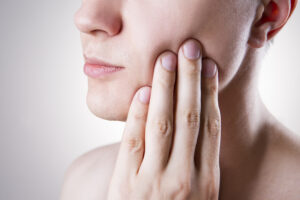Written by Taylor Woosley, Staff Writer. Subjects in the licorice gargle juice group showed significant improvement in pain scores from baseline to the second day of treatment, with 25% experiencing complete ulcer healing on day 2 compared to the control group.
 Mouth ulcers represent a very common unpleasant oral mucosal disease that can reduce patient’s quality of life1. The ulcer site is often covered with a yellow or gray pseudomembrane, with hyperemia in the surrounding mucosa2. It is caused by various factors such as viral, fungal, and bacterial infections, allergic reactions, and systemic diseases3.
Mouth ulcers represent a very common unpleasant oral mucosal disease that can reduce patient’s quality of life1. The ulcer site is often covered with a yellow or gray pseudomembrane, with hyperemia in the surrounding mucosa2. It is caused by various factors such as viral, fungal, and bacterial infections, allergic reactions, and systemic diseases3.
Licorice (Glycyrrhiza glabra) is a well-known natural herb to treat different ailments4. It contains over 400 compounds, including glycyrrhizin which has shown beneficial effects in preventing and treating oral diseases5. Licorice has well known properties such as antiviral, anti-inflammatory, antioxidant, and anti-ulcerative6.
Liu Hsin-Li et al. conducted a randomized, double-blind, placebo-controlled trial to assess the effectiveness of a natural licorice root gargle juice for treating aphthous ulcers and to reduce pain and promote healing. Subject inclusion consisted of being 20 years or older suffering from aphthous ulcers confirmed by dental physicians. Subjects were randomized between the intervention group (n=30) and placebo (n=24) group. The intervention group were given a licorice mouthwash juice containing 40g licorice root. The control group received a xylitol mouthwash juice containing 2mg of xylitol. All participants rinsed for 10-20 seconds four times daily.
Participants completed a personal informational questionnaire and an ulcer type diagnosis assessment performed by dental physicians with information regarding ulcer size and type. Outcome measurements included changes in pain score, which was measured using a visual analogue scale (VAS) measured at baseline, day 1 and day 2 of treatment. The nonparametric Mann-Whitney test was utilized to compare the measurements of the VAS scores of days 0, 1, and 2 and to compare the pain experience before and after pain scores.
The patients in both groups (30 females and 24 males; mean ±SD age 37.72 ± 17.21) recorded a pain degree of 5.52 ± 1.95. No significant difference was observed between pain scores of the treatment and control group before randomization (mean VAS, 5.53 [95% CI, 4.90-6.17] vs. 5.50 [4.54-6.46]; P = 0.96). Significant VAS reduction of oral ulcers was noted in the licorice gargle juice compared with the control group during day 1 (mean VAS, 2.47 [95% CI, 1.95-2.98] vs. 4.75 [3.96-5.54]; P<0.001) and day 2 after treatment (mean VAS, 1.07 [95% CI, 0.81-1.32] vs. 4.08 [3.23-4.94]; P<0.001).
Results of the study show that 2-day treatment of a licorice mouthwash juice effectively improved pain scores and promoted healing of aphthous ulcers compared to the control group. Further research should continue to explore the use of licorice on various inflammatory-based oral diseases and conditions.
Source: Liu, Hsin-Li, Po-Ya Hsu, Yueh-Chin Chung, and Kuan-Yu Lin. “Effective licorice gargle juice for aphthous ulcer pain relief: A randomized double-blind placebo-controlled trial.” Pakistan Journal of Pharmaceutical Sciences 35, no. 5 (2022).
Click here to read the full text study.
Posted February 9, 2023.
Taylor Woosley studied biology at Purdue University before becoming a 2016 graduate of Columbia College Chicago with a major in Writing. She currently resides in Glen Ellyn, IL.
References:
- Dalessandri D, Zotti F, Laffranchi L, et al. Treatment of recurrent aphthous stomatitis (RAS; aphthae; canker sores) with a barrier forming mouth rinse or topical gel formulation containing hyaluronic acid: a retrospective clinical study. BMC Oral Health. Jul 16 2019;19(1):153. doi:10.1186/s12903-019-0850-1
- Cheng B, Zeng X, Liu S, Zou J, Wang Y. The efficacy of probiotics in management of recurrent aphthous stomatitis: a systematic review and meta-analysis. Sci Rep. Dec 3 2020;10(1):21181. doi:10.1038/s41598-020-78281-7
- Sunagawa M, Yamaguchi K, Tsukada M, Ebihara N, Ikemoto H, Hisamitsu T. Kampo (Traditional Japanese Herbal) Formulae for Treatment of Stomatitis and Oral Mucositis. Medicines (Basel, Switzerland). Dec 10 2018;5(4)doi:10.3390/medicines5040130
- Jain R, Hussein MA, Pierce S, Martens C, Shahagadkar P, Munirathinam G. Oncopreventive and oncotherapeutic potential of licorice triterpenoid compound glycyrrhizin and its derivatives: Molecular insights. Pharmacol Res. Apr 2022;178:106138. doi:10.1016/j.phrs.2022.106138
- Sidhu P, Shankargouda S, Rath A, Hesarghatta Ramamurthy P, Fernandes B, Kumar Singh A. Therapeutic benefits of liquorice in dentistry. J Ayurveda Integr Med. Jan-Mar 2020;11(1):82-88. doi:10.1016/j.jaim.2017.12.004
- Wu Y, Wang Z, Du Q, et al. Pharmacological Effects and Underlying Mechanisms of Licorice-Derived Flavonoids. Evid Based Complement Alternat Med. 2022;2022:9523071. doi:10.1155/2022/9523071
